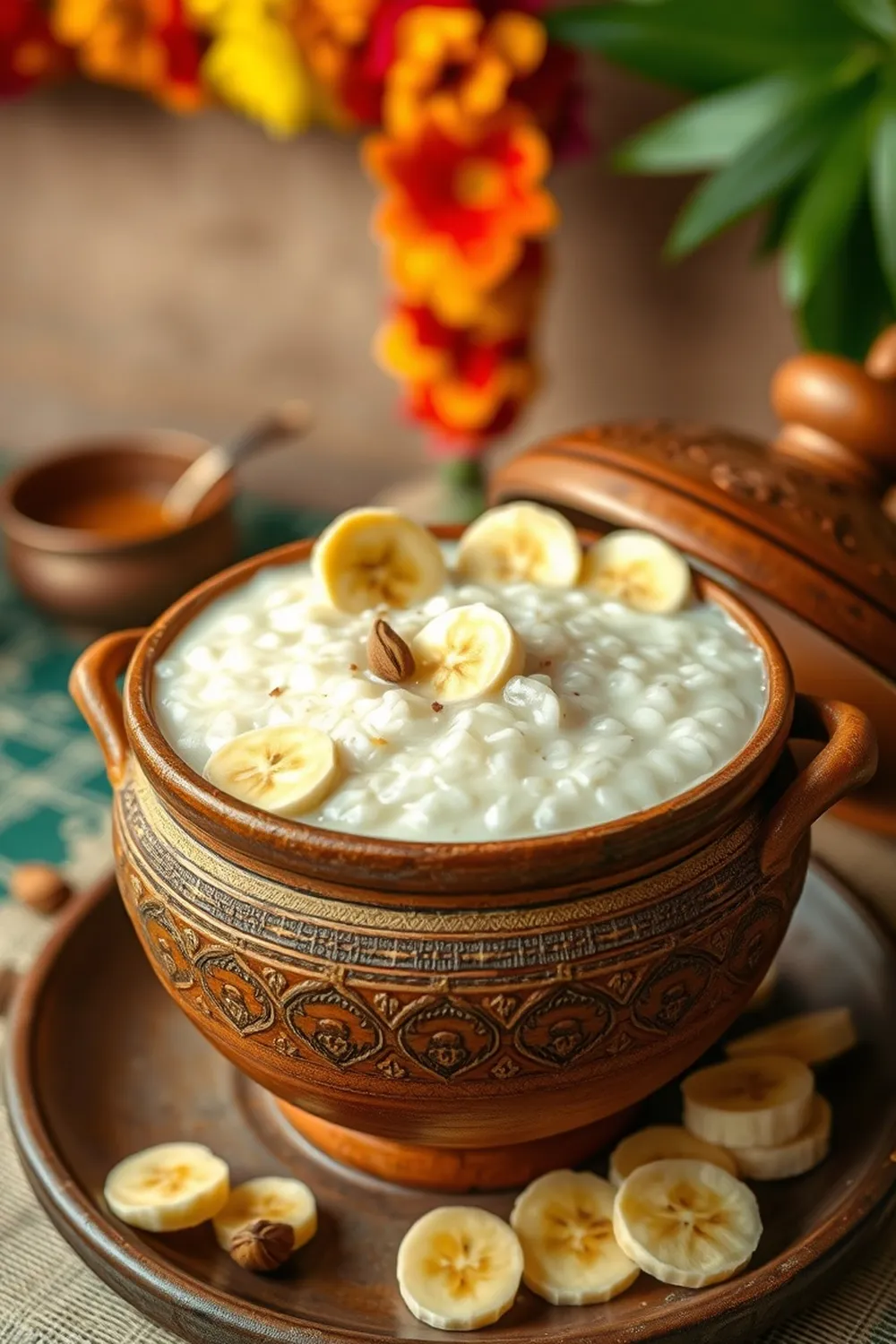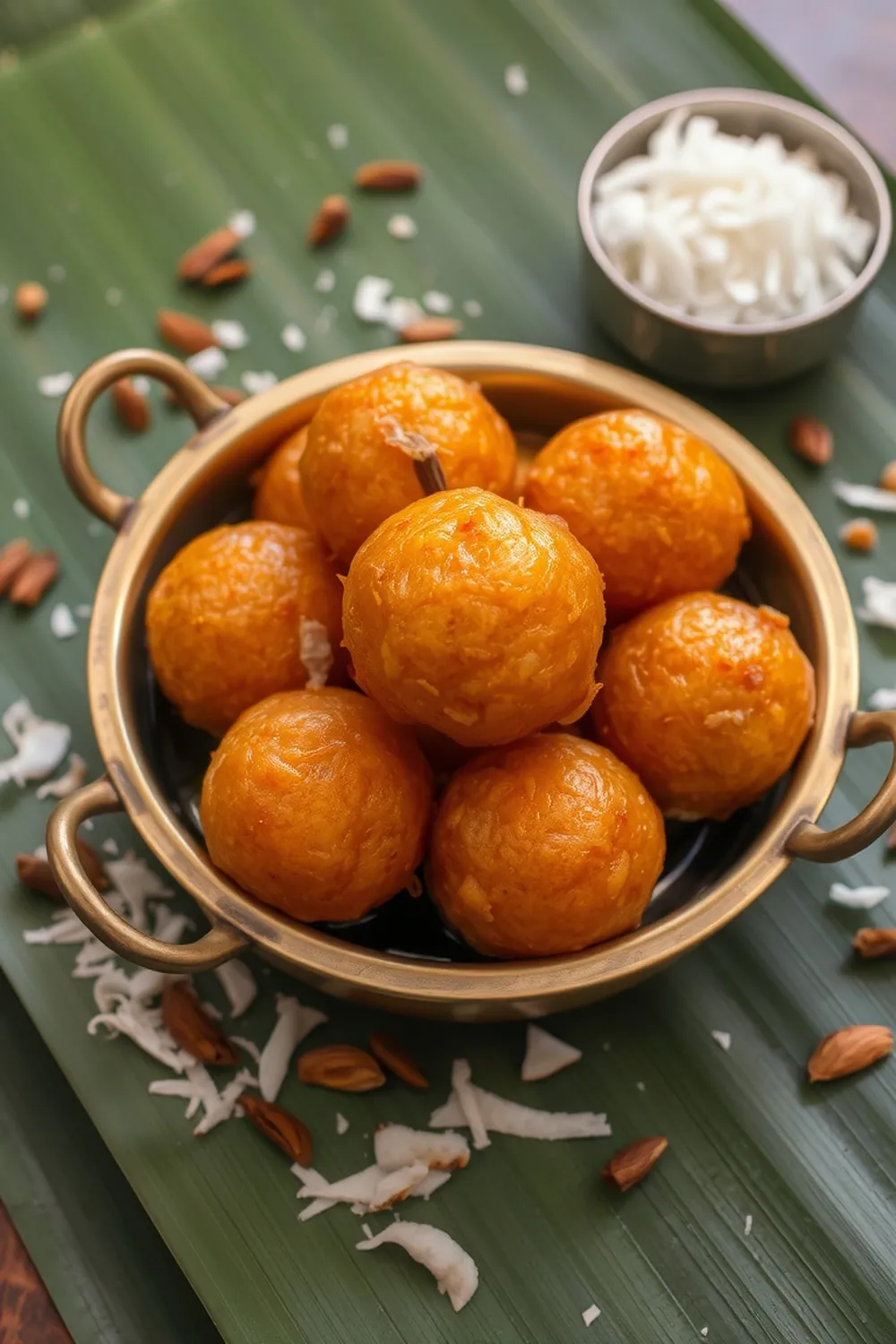- Wash and soak idli rice, raw rice (or parboiled rice), urad dal, and methi seeds together for 4-6 hours.
- Grind soaked ingredients into a thick, smooth batter. Ferment for 8-12 hours, or overnight.
- Prepare palm jaggery syrup by dissolving palm jaggery in water and heating until dissolved. Strain to remove any undissolved particles or impurities.
- Mix 2 cups of fermented batter with jaggery syrup, grated coconut, and cardamom powder. Adjust consistency with a little water if needed to avoid a very thick batter.
- Heat a paniyaram pan. Add a small amount of ghee or oil to each mold. Pour batter into the molds, filling them about 3/4 full, and cook covered on medium-low heat until golden brown.
- Carefully flip paniyarams to cook the other side until golden brown and crispy. Serve warm.
- Calories:120 kcal25%
- Energy:502 kJ22%
- Protein:2 g28%
- Carbohydrates:20 mg40%
- Sugar:8 mg8%
- Salt:10 g25%
- Fat:3 g20%
Last Updated on 6 months ago by Neha Deshmukh
Authentic Paniyaram Recipe – Palm Jaggery & Coconut Sweet Pancakes
Introduction
Oh, Paniyaram! These little golden pancakes hold such a special place in my heart. I remember my grandmother making these during festivals, the aroma of jaggery and cardamom filling the entire house. They’re a delightful treat, and honestly, once you make them, you’ll be hooked. This recipe uses palm jaggery, which gives it a unique, almost caramel-like flavour that’s just divine. Let’s get cooking, shall we?
Why You’ll Love This Recipe
These aren’t just any pancakes. Paniyaram are a South Indian classic, offering a wonderful blend of sweet and subtly spiced flavours. They’re perfect for a quick breakfast, a satisfying snack, or even as an offering during festive occasions. Plus, they’re surprisingly easy to make once you get the hang of it! You’ll love how the crispy exterior gives way to a soft, fluffy interior.
Ingredients
Here’s what you’ll need to create these little gems:
- 1.5 cups Idli rice
- 0.5 cup Raw rice
- 0.33 cup Urad dal (split black lentils)
- 0.25 tsp Methi seeds (fenugreek seeds)
- As needed Salt and water
- 2 cups Paniyaram batter / Paniyaram Maavu (after fermentation)
- 0.5 cup Powdered Palm jaggery / Karupatti
- 2 Cardamom pods
- 0.25 cup Grated coconut
- As needed Ghee (for cooking)
Ingredient Notes
Let’s talk ingredients! A few notes to help you get the best results:
- Palm Jaggery / Karupatti: This is the star! It’s unrefined sugar made from palm sap, and it lends a beautiful, smoky sweetness. If you can’t find it, you can use regular jaggery, but the flavour won’t be quite the same. (More on that in the FAQs!)
- Methi Seeds: Don’t skip these! They add a lovely subtle flavour and aid in fermentation. Plus, methi seeds are fantastic for digestion – a little bit of traditional wisdom packed into these pancakes.
- Urad Dal: This lentil is key for that light and fluffy texture. Make sure yours is fresh for the best fermentation.
Step-By-Step Instructions
Alright, let’s get down to business!
- First, wash the idli rice, raw rice, urad dal, and methi seeds together. Soak them in plenty of water for at least 2 hours. This is crucial for a smooth batter.
- Once soaked, drain the ingredients and grind them into a thick, smooth batter. Add water gradually while grinding to achieve the right consistency.
- Now, for the magic! Let the batter ferment overnight, or for at least 8-12 hours. The warmer the environment, the faster it will ferment. You’ll know it’s ready when it’s bubbly and has a slightly sour aroma.
- While the batter ferments, prepare the palm jaggery syrup. Dissolve the powdered palm jaggery in about 1/2 cup of water. Strain it to remove any impurities.
- Time to combine everything! In a large bowl, mix 2 cups of the fermented batter with the jaggery syrup, grated coconut, and cardamom powder (lightly crushed). Adjust the consistency – it should be thick enough to hold its shape but not too runny.
- Heat a paniyaram pan (a special pan with little molds) over medium heat. Add a little ghee to each mold.
- Pour the batter into each mold, filling it about ¾ full. Cover the pan and cook for about 3-4 minutes, or until the bottom turns golden brown.
- Carefully flip the paniyarams and cook the other side for another 2-3 minutes, until golden and cooked through.
- Serve warm and enjoy!
Expert Tips
- Don’t overmix the batter after adding the jaggery syrup. Gentle mixing is key.
- If the batter is too thick, add a little water. If it’s too thin, add a tablespoon or two of rice flour.
- Keep the heat medium to avoid burning the paniyarams.
- A well-seasoned paniyaram pan is your best friend!
Variations
- Vegan Adaptation: Use plant-based ghee (like coconut oil) and double-check that your palm jaggery is processed without bone char (some brands use it).
- Gluten-Free: This recipe is naturally gluten-free!
- Spice Level: Feel free to add a pinch of nutmeg or a tiny bit of grated ginger for a warmer flavour.
- Festival Adaptations: Paniyaram are traditionally offered to Lord Ganesha during Ganesh Chaturthi/Vinayaka Chavithi. My family always makes a larger batch during this time!
Serving Suggestions
Paniyaram are delicious on their own, but they’re even better with a side of coconut chutney or a dollop of yogurt. My personal favourite is a simple coconut chutney – it complements the sweetness perfectly.
Storage Instructions
Leftover paniyarams can be stored in an airtight container at room temperature for a day, or in the refrigerator for up to 3 days. Reheat them gently in a pan or microwave before serving.
FAQs
- What is the best way to ferment the batter for Paniyaram? Keep the batter in a warm place, covered loosely. In colder climates, you can place it near a warm oven or in a slightly preheated (then turned off!) oven.
- Can I use regular sugar instead of palm jaggery? What’s the difference in taste? You can, but the flavour will be different. Palm jaggery has a deeper, more complex flavour with smoky notes. Regular sugar will make the paniyarams sweeter, but lack that unique depth.
- My Paniyaram is sticking to the pan – what am I doing wrong? Make sure your pan is well-seasoned and you’re using enough ghee in each mold. Also, ensure the pan is hot enough before adding the batter.
- What is the significance of Methi seeds in this recipe? Methi seeds aid in fermentation and add a subtle flavour. They’re also considered beneficial for digestion in Ayurveda.
- Can I make the batter ahead of time and store it? Yes, you can! You can grind the ingredients and store the batter in the refrigerator for up to 2 days. Just remember to let it come to room temperature before fermenting.
- What is the traditional accompaniment to Paniyaram? Coconut chutney is the classic pairing, but yogurt or even a simple filter coffee also go wonderfully with it.










